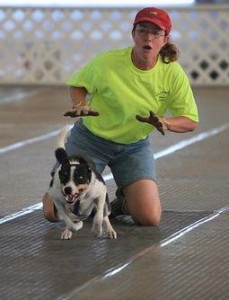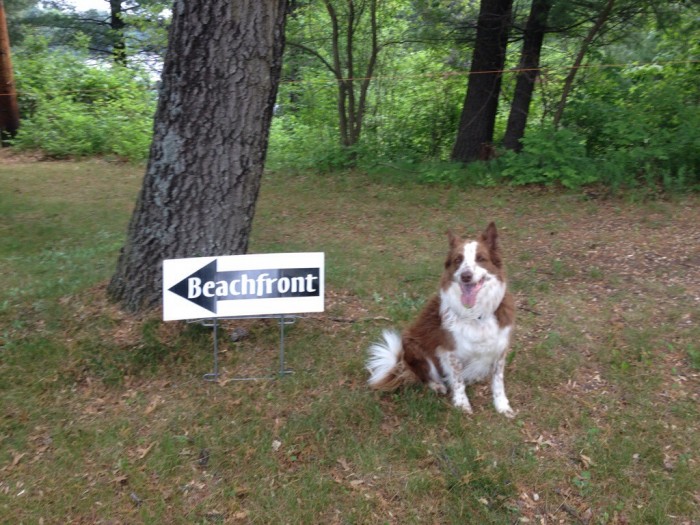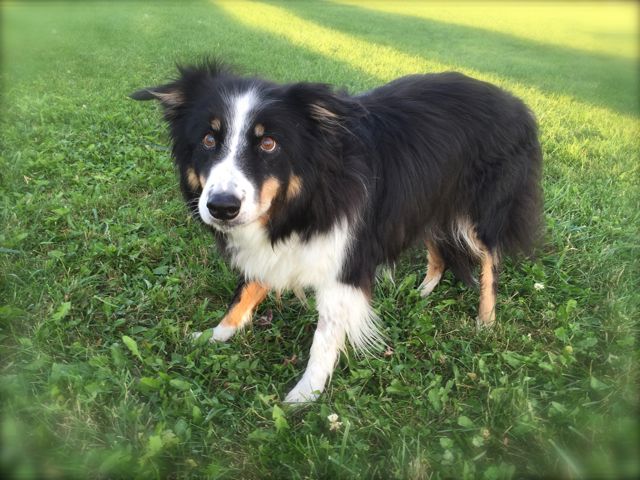Muliple Choice – Can you choose “all the above” ?
Can my dog excel at multiple sports? This is a question that is asked time and time again. So, I thought that others would be interested in my personal experiences with this.
I share my life with wonderful performance dogs and think every one of them have a special thing they were meant to do.
Many folks know my pup, Riff. He is an amazing athlete and performance dog. As a puppy, he started in both agility and flyball. We took them both slow since he didn't! With flyball, we concentrated on correct jumping style, nice box turn to prevent injury, tugging and the most important thing: leaving each session with a desire to do more. So all his sessions were short and sweet. He ran in his first tournament just after a year old and we quickly realized that we had a star on our hands. He has been running flyball ever since and consistently runs in 3.7 seconds and posts a 3.6 every now and then. He was voted the regions MVP after his first year of running and placed in the top 5 fastest dogs in North America for the first 4 years of running. His team has won the top team in the region for 4 years in a row and Riff won the Single Dog racing at the two National events we attended. If you've ever seen him run, he's a joy to watch. He looks effortless as he speeds over the jumps and if you blink, you've missed his box turn. A truly amazing athlete and performer.
and posts a 3.6 every now and then. He was voted the regions MVP after his first year of running and placed in the top 5 fastest dogs in North America for the first 4 years of running. His team has won the top team in the region for 4 years in a row and Riff won the Single Dog racing at the two National events we attended. If you've ever seen him run, he's a joy to watch. He looks effortless as he speeds over the jumps and if you blink, you've missed his box turn. A truly amazing athlete and performer.
When he was a pup, I also put him through 2 sessions of puppy agility class and the 16 week foundation class so he learned all the obstacles and basic handling moves. But, with the amazing runs in flyball and we only had time for one sport – flyball it was.
Things changed, and in the last couple of years, we have done less flyball. We had an older dog that couldn't travel or sit in a crate for long periods of time. We also started adding animals to our small farm and needed more time spent taking care of them. Since most flyball tournaments around us requires at least a couple of nights on the road and a full weekend away from home, it just wasn't fitting into our lifestyle any longer. So, what do I do with this amazing athlete, and how do I satisfy his need for performance? He'd be happy sleeping on the couch and having multiple "chuck it" sessions a day. But in his heart, he loved to perform. So to honor that heart desire, I needed to find a new outlet that worked for all of us. We started back in agility. I have learned so many things from this in the last few years, here are some things to consider if you are thinking the same thing. (Before you read on, realize that I ask a lot of my dogs. I am very particular about my dogs doing things properly and safely since I'd like them to have a long, healthy performance career. With this particular dog, he is such an amazing athlete, I knew he would require extra effort and would advance quickly. So, I am not about getting it "good enough", but instead I'm looking ahead at what I'd like them to learn for many amazing runs to come.)
Riff had primarily been doing flyball for 5 years. So when we switched gears to agility, as a team, we had lots of things to work on. The first big challenge I had with Riff was impulse control. I don't mean lunging at other dogs – he was perfectly happy waiting his turn, and after one quick correction, he never made a peep in class while watching other dogs run. He knows he'll get his turn. Flyball teaches dogs to run ahead and do the "course" and return for a reward – tugging!!! Once they understand the game, very little input from the handler is needed. So, at first in agility, as long as he got the gist of my direction on the course, he'd just happily forge ahead at the obstacles (he loved tunnels!) and return for his tuggy, having no clue there was a sequence to things and that the sequence changes nearly every time.
Riff could properly perform all the equipment, but while other dogs were running small sequences, we were working on one jump (of my choosing) and return to tuggy. At first it was a little disappointing – here is this rocket dog, and we're slowing him down. But it was really to teach him to think about what I was asking versus just go, go go. We also realized he could properly jump his height if things were slower. When you added the speed (the way Riff does everything), he would tick the jumps. So we started by retraining him to jump properly by starting at lower heights and to be aware of his launching position versus just blasting jumps. We progressed quickly through the heights but making sure that his jumping style was always correct when we did. The criteria wasn't that he simply jumped the higher height, but did he jump it correctly. We worked on a lot of foundational jumping techniques. He knew how to jump in flyball, but to add height with speed – that was a different set of muscles he needed to develop. We also worked a lot on him caring what I was doing, ha, ha. I needed to stay calm and be very clear on what I was telling him to do. In flyball, it's a lot of very fast, furious motion, and by the time the dogs are running in a tournament, they really need very little input from us as to what to do. As long as I had tuggy, we were a team. But add a little speed and no tuggy – hmm. He's off on his own.
Speaking of tuggy – he had a bad case of flyball tugging. In flyball, he wasn't so accurate in reaching for the tug and would sometimes grab a body part if it was in the wrong place. Ouch – my fingers! As I taught him, he would continue tugging until we lined up for the next race. In agility – particularly in training – I need a quick release of the tug to continue the next sequence. Hmm, this was a challenge. So, several training session were just spent working with the tug. Grabbing it properly, releasing it (and not diving after it when I went to reach for it) and then letting him get it when it was the right time. I found a wonderful instructor that knew just how to work with these issues and was very patient with both of us. She helped us realize that these small foundational training pieces would be critical for our success as a performance team. Knowing that I am not just casually going to invest in a new sport, she worked with both of us to get it right. Riff is an amazing athlete and performance dog – he deserves the best I can give him.
More posts to come. In the next one, I'll talk about how speed affected his contacts, what I did to help him and how I changed his training program to be more aligned for agility. In following posts, I'll talk about how this new training affected his performance in flyball and how I evaluated his weight for these two different sports.
I invite you to share your comments and experiences on my FaceBook page.


